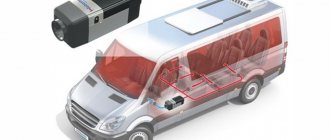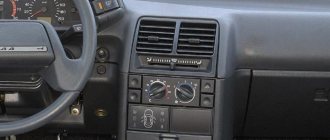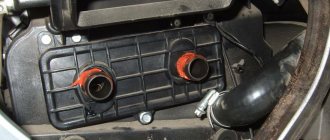In cold weather, the first instinct when getting into a car is to stay warm. At the same time, not only our body experiences discomfort, but also the mechanisms of the car itself.
In particular, at sub-zero temperatures, problems may arise with starting the power unit and warming it up. In both the first and second situations, an autonomous interior heater can help out.
What are the features of this device? What types of heaters are there? How do they work? Below we will look at each of the questions in detail.
What is a cabin heater?
One of the main problems of operating a car in winter is difficulty starting the power unit. In cold weather, due to the high viscosity of the oil, the engine starts poorly and requires pre-heating. The standard heater cannot cope with this task, since it turns on only when the power unit is running.
It is also irrational to use engine-powered stoves during long periods of parking. To do this, you need to start the engine, which entails high fuel consumption: even at idle, the power unit of a cargo vehicle similar to KamAZ “eats” about 8 liters of fuel per hour. In this case, the constant operation of the piston group is also unjustified, which leads to its premature wear.
Another aspect of the problem is the environmental component. If the driver has to stop in the city or in a public parking lot, the noise of the running engine and exhaust fumes will cause a lot of dissatisfaction among others.
For Russian drivers, all these issues are most relevant, because in most regions the cold period occurs for more than 6 months a year. What can we say about the Far North, where during the times of the USSR and cheap “state” diesel fuel, diesel engines were practically not turned off in winter? Pre-heating installations, which, in particular, were installed on military equipment, helped to prevent such a barbaric attitude towards cars to some extent. However, they did not solve the problem of heating the cabin.
In warmer Western Europe, there were significantly fewer problems with winter operation of cars, but it was from there that the trend came to install autonomous heaters on cars. Germany has achieved particular success in this matter, where the law prohibited turning on the engine while parked. And even though it is customary for German truckers to spend the night in comfortable motels rather than in trucks, and winters are much milder, a few hours spent in a windy warehouse or customs office made us think about an alternative solution to the problem. This is how the idea of heating with an air dryer came about. In the USSR, similar devices were manufactured by the Shadrinsky Automotive Aggregate Plant and installed on Zaporozhets. However, they were extremely capricious, unreliable and often caused fires. For the most part, domestic drivers continued to use handicraft inventions such as transferring heat to the cabin via copper wire wound around the exhaust pipe. They learned about high-quality interior heaters only during the period of mass import of foreign cars, including minibuses, into the country. These devices operated autonomously in economical mode and provided heating for a long time.
Why are interior heaters needed?
Starting and heating a car in cold weather is a big problem. Especially in the morning, when you have to rush to work. To speed up the process, interior heaters were developed.
These devices turn on simultaneously with the engine and manage to heat the car before turning on the stationary stove, which usually needs at least half an hour to reach the desired temperature.
Important! Some car owners consider an additional heater overkill. But they do not take into account one important point - a conventional stove is turned on manually and the driver has to sit in a cold cabin. With a heater, such discomfort is eliminated: while the engine is warming up, the interior also heats up, so even in cold weather it will be pleasant to get into it.
Don't forget to look:
The best brands of liquid glass for cars The best windshield wiper blades for cars
Interior heater diagram
The design of autonomous heaters varies depending on the type and model. The general layout of the interior heater includes:
- combustion chamber;
- heat exchanger;
- fan;
- some models have a separate fuel tank;
- hoses for supplying air to the combustion chamber and removing exhaust gases.
The equipment set includes a fuel pipe, a fuel line pump, wires, and fasteners.
Table: technical characteristics of Webasto Air Top 2000 ST
| Permissible fuel supply height H (m) | 1-2 |
| Permissible fuel suction height S (m) | 1 |
| Maximum permissible excess pressure in the fuel line (bar) | 0,03-0,11 |
| Maximum permissible vacuum in the fuel tank (bar) | -0,02 |
| Voltage, V | 12 for petrol, 12/24 for diesel units |
| Fuel | petrol/diesel |
| Heating power, kW | 2 |
| Power consumption, W | 14 — 29 |
| Fuel consumption, l/hour | 0,14 — 0,27; 0,12 — 0,24 |
| Max. volume of supplied air, m3/h | 78 |
| Weight, kg | 2,6 |
| Dimensions, mm | 311 x 120 x 121 |
Sources
- https://AutoTopik.ru/obuchenie/949-avtonomnye-otopiteli-salona.html
- https://SwapMotor.ru/instrument-i-oborudovanie/avtonomnyy-otopitel-salona.html
[collapse]
How does an auxiliary heater work?
It is very easy to understand how an air car heater works:
- Fuel enters the combustion chamber and is ignited.
- Cold air from the passenger compartment is forced by a fan into the flame tube area, where it is heated.
- The heated air masses return to the cabin.
- Combustion products are removed from the chamber through a heat-resistant sleeve.
Devices that additionally perform the function of engine preheating have a common circuit with the cooling system.
How to use an autonomous heater?
Before you start using your car's autonomous heater, you need to check its functionality. Diagnostics are performed automatically, and fault information is displayed as a code on the display, for example:
- 011 or 002 – low voltage;
- 012 – overheating.
It is not recommended to ignore these messages: in case of critical problems, the operation of the heater will be blocked.
If everything is normal, the fuel is ignited and the fan turns on. If smoke appears, you need to check the condition of the air intake; it may be covered with snow. In the worst case, smoke is caused by a broken control unit. The fan should operate without squeaks: extraneous noise is a sign of broken bearings.
The autonomous unit is capable of heating for a long time, but if the voltage drops, it will automatically turn off in order to maintain the ability to start the engine.
General recommendations include using only high-quality fuel, otherwise it may thicken and the device will refuse to work.
Every year, before the onset of cold weather, you need to perform a test run and check the condition of the air ducts and filter. It is better to do this ahead of time, so that if any malfunctions are detected, you have time to contact a car service center before there is a queue with similar problems.
Types of interior heaters
All modern interior heaters are classified by type into:
- air;
- liquid;
- gas;
- electric.
Interior air heater
The first representatives of autonomous interior heaters were air heaters with the operating principle of a conventional hair dryer. The air flow is passed through the heating element and supplied to the cabin by fans. In older models, the function of the heating element was performed by a metal spiral, then it began to be replaced with ceramics, which made it possible not to dry out the air and maintain normal humidity.
Interior liquid heater
The heaters are integrated into the overall car system: the power is connected to the standard fuel line, and the electrical components are connected to the car’s electrical circuit. When the device is turned on, the liquid in the cooling system is heated and passed through the engine and radiator. As the desired temperature is reached, the fan turns on and warm air enters the cabin. The device automatically reads readings from temperature sensors, regulates the pumping of refrigerant and the intensity of the fan.
The interior liquid heater can be started manually or automatically according to a precisely specified switching time. The remote control device included in some models allows you to issue commands from a distance of up to one kilometer.
Gas interior heater
The operating principle of gas interior heaters is similar to liquid models, with the difference that they are not connected to the vehicle’s fuel system. Propane is used as fuel, which is supplied by a separate reducer. Gas enters the chamber through a nozzle, which sprays it. Automation regulates pressure, injection force and temperature indicators.
In terms of efficiency, gas models are not inferior to liquid ones, and in some characteristics they are superior to them.
Electric interior heater
Heater models operating from a household AC power supply of 220 V cannot be classified as autonomous. It is convenient to use such devices for pre-heating the engine and heating the interior in parking lots equipped with sockets, however, if the stop occurs in an open field or just in the middle of the street, then an electric interior heater is of no use.
Do-it-yourself primitive heating of the interior of any car in winter: current technologies
Fan heater
Those who like simple solutions will like additional means of heating the interior. Designing a car heater from a cigarette lighter with your own hands is one of the simple and affordable options for designing additional heating. The advantages of such a device are difficult to underestimate:
- Fuel and oxygen are not burned.
- Possibility of use in cars of any class.
- Compact design.
A similar solution is commercially available. Its name is a 12 Volt car fan heater. The main disadvantage is low efficiency: it cannot create a microclimate alone. It is recommended to use the car heater only as an addition to standard heating devices. Yours is more reliable and, moreover, repairable - all by analogy with winter washers: a homemade anti-freeze recipe is much better than a roadside canister of an unknown potion.
Ceramic oven
Using combustion gas as a heat source is an effective way to quickly raise the temperature to comfortable levels. The minimum elements are a ceramic stove and a 15-liter gas cylinder. The risk of fire and intense oxygen combustion limit the demand for this type of heating.
Modify the factory furnace
It is preferable to take the path of improving standard equipment, but the costs are incomparable. Modifying a heater is not an easy task: it requires skill and the elements are compact in size. It is not a fact that an additionally installed radiator will have an effect, since it is difficult for the fluid to warm up to operating temperature. Another thing is to introduce an electric heater from a diesel modification (RTS) - the effect is obvious. In addition, warm air flows immediately after starting the engine.
Types of interior heaters by power source
Depending on the type of fuel, auxiliary heaters are:
- electric for 12 and 24 V;
- gasoline;
- diesel;
- gas.
Interior heater 12 volts
These are compact, low-power mobile interior heaters (up to 200 W), powered by a 12 V car cigarette lighter. Their function is limited to heating the driver’s seat and windshield. Such devices can be quickly installed and removed by yourself.
Interior heater 24 volts
24 V interior air heaters are similar to previous devices, but are used primarily in trucks. Instead, you can use 12-volt models with a current converter.
Petrol interior heater
Unlike air heaters, gasoline heaters perform 2 functions at once: heating the interior plus pre-heating the engine. Gasoline models are more efficient than air models, but are more expensive and require complex installation.
Diesel interior heaters
Structurally, diesel interior heaters are identical to gasoline ones. Their power reaches 5 kW or more, and fuel consumption averages 0.4 liters per hour, which is 40 times less than when the engine is running.
Types of interior heaters by vehicle type
When choosing a heater, it is important to correctly calculate the required power. Many PBX owners believe that the larger it is, the better. However, this opinion is wrong. Unreasonably high heater power will lead to excessive fuel consumption and premature wear of the equipment.
Air heater for passenger car interior
If you need to completely heat the passenger car interior, then it is enough to install a liquid model of an autonomous heater with a power of up to 2 kW. To heat one driver's seat, you can use a “dry hairdryer”.
Air heater for truck interior
The choice of an autonomous heater for a truck depends on the dimensions of the vehicle and the heated area. To heat the driver's seat, you can use an "air"; for a small cabin, a power of 2 kW is sufficient. If the cabin is high and equipped with a berth, then a heater of up to 4 kW will be required, and for heating the cargo compartment - 5 kW or more.
Heater for minibus interior
To heat the interior of a minibus with a passenger capacity of up to 12 seats, a 3 kW heater is sufficient. On larger machines, 4-4.5 kW equipment is installed.
Bus interior heater
For the bus interior you need to choose heaters with a power of 4.5-5 kW
In what cases and on what vehicles are heaters used?
The task of autonomous interior heaters is to maintain optimal temperature in the cabin or luggage compartment.
Feature: operation without starting the power unit. The principle of operation is based on capturing air, warming it up and sending it back into the cabin.
The devices can operate in several modes - with air intake from outside or in standard ventilation mode.
The heater is started by an external thermostat or a built-in timer (programmed by the car owner).
Autonomous interior heaters provide a comfortable temperature for the work of different categories of motorists - operators of special equipment, truck drivers, truckers, and so on.
Any of these professions requires maximum attention and has an increased level of complexity. Full heating allows you to perform the assigned tasks efficiently.
In the CIS countries, the cold season lasts for 4-5 months, so the use of special heaters is very important.
These devices are installed in ambulances, truck cabins, vans with cargo sensitive to cold weather, and so on.
The heater will be useful in the interior of a minibus, in the compartments of truck drivers, in the cabins of construction and road special equipment.
High-quality and timely warming up eliminates the problem of driver freezing and prevents icing of the windows and control panel.
Frequently warming up the car while idling is ineffective and leads to excessive fuel consumption. That is why heating devices, distinguished by their autonomy, are so popular among car enthusiasts.
Characteristics of autonomous interior heaters:
- high-quality heating of the cabin even in severe frost;
- autonomy from the engine, fuel tank and battery (not relevant for all models);
- ease of use and reliability (no rotating elements, no electronic parts);
- fuel economy;
- no harmful emissions into the atmosphere.
WEBASTO (3)
Webasto
Founded in 1901, the German company Webasto is a recognized leader in the field of climate control technology for vehicles. The Webasto line includes air, gasoline and diesel heaters with a power from 2 to 5.5 kW. The company's products are in great demand all over the world, including in Russia. In particular, Webasto equipment is installed on the racing cars of the KamAZ Master team.
Planar
Under the Planar brand, diesel heaters are produced by the Samara enterprise Advers. The product line consists of models with a power of 2-8 kW. With high quality, they are significantly lower than their foreign analogues. The products have international certification and are successfully sold abroad, including in the USA.
Aero comfort
Aero Comfort heaters are another Russian development that can compete in quality and price with foreign analogues. The products are manufactured by the TeploAvto enterprise from Naberezhnye Chelny. Available in 2 and 4 kW models.
Table: technical characteristics of Webasto Air Top 3500
| Heating power, kW | 3,5 |
| Rated voltage, V | 12/24 |
| Fuel | diesel |
| Fuel consumption, l/h | 0,42 |
| Power consumption, W | 36** |
| Supply volume air, m 3 / h | 138 |
| Heater dimensions, mm (length x width x height) | 425 x 148 x 148 |
| Weight, kg | 5,9 |
| Internal temperature control range | -40… +20 °C |
| Volumetric flow of heated air at fan speed, relative to 0.5 mbar | Max. 132 (200) m3/h at 3600 (5000) rpm |
| CO2 in flue gases (permissible operating range) | 1.5 kW: 5.0-8.0%; 3.5/5.0 kW: 9.0-12.5% |
Additional interior heater: pros and cons
While the car's standard heater is powered by the internal combustion engine, an additional heater provides heat to the vehicle's interior while parked with the engine turned off. Each type of auxiliary heater has its own advantages and disadvantages.
Dry air dryers
Pros:
- compact;
- do not consume gasoline (diesel);
- easy to install and remove.
Minuses:
- low-power;
- drain the battery;
- do not provide engine warm-up.
Liquid and gas
Pros:
- high power;
- possibility of remote control and automatic start at a specified time;
- engine pre-heating;
Minuses:
- emit combustion products, which is why they cannot be used in closed parking lots;
- require complex installation with connection to vehicle systems.
Electrical 220 V
Pros:
- have high power;
- do not consume the vehicle’s energy resources (battery charge and fuel);
- can be used in closed parking lots;
Minuses:
- take up a lot of space;
- require connection to a household electrical outlet.
To provide themselves with warmth under any circumstances, drivers often install 2 heaters of different types.
Installation of an autonomous heater
The equipment is located in the car interior or in the engine compartment. In the first case, it is necessary to remove the hoses for supplying air to the combustion chamber and exhaust gases to the outside, in the second, to ensure the supply of heated air inside. General algorithm for installing the interior heater:
- Selecting the location of the heater unit and fixing it.
- Connection to the fuel line (if power is not provided from your own tank).
- Connection to the fuel line.
- Installing the control unit on the dashboard.
- Integration of AO into the cooling circuit.
- Installation of air ducts.
How to start an autonomous heater?
Before installing and starting the autonomous heater, you need to make sure that its device characteristics correspond to the on-board parameters. Subsequent actions are carried out in accordance with the operating instructions. We recommend ordering the installation of the heater from a certified company, where they will make a professional selection of equipment for your vehicle.
Installing an autonomous heater in a car
The use of 220 V electric heaters or dry hair dryers does not require special installation. To operate, they simply connect to the power supply. The situation is different with liquid and gas models. They are integrated into the structure of the car and affect its important components: fuel line, cooling system, electrical circuit. Therefore, it is better to install such an autonomous heater on a car at a car service center. In this case, you are guaranteed to receive maximum productivity from the device and consultation with a specialist. However, with a sufficient level of preparation, you can complete the installation yourself.
Installing an autonomous heater on a truck
Installing an auxiliary heater on a truck is often done outside the cab under the hood of the vehicle. In this case, the hoses through which warm air enters are routed inside through existing or made holes.
Do-it-yourself installation of an autonomous heater in a car
If you have sufficient skills, you can install an autonomous liquid-type heater on a car yourself. In this case, you need to pay attention to the routing of wires and the fuel pipe. To avoid tears, bends and contact points with sharp edges of the body are reinforced with cuffs.
After installation is completed, it is necessary to check the tightness and reliability of fixation of all elements, conduct a test run, measuring the level of current consumption and heating temperature.
Manufacturers
The most popular manufacturers among domestic car enthusiasts are:
- Lifey is a Chinese manufacturer of automotive components. It gained popularity due to its favorable price. Small units can be purchased for between 1500-2000 rubles, which is significantly cheaper than their closest competitors. However, the disadvantage of the manufacturer is the unstable quality inherent in all budget manufacturers, while all installation work can be done with your own hands.
- Webasto - one of the market leaders producing equipment for heating cars. It is distinguished by consistently high quality and the same high cost. Units from this company are characterized by high endurance (on average they can last for 7-8 years);
- KRC is an automotive components company. It has been present on the market not long ago and is fighting against competitors by balancing attractive prices and fairly high quality products. According to the developer, the service life of the product is about 4-5 years.
How to choose an autonomous heater for your car
The car market offers a large number of additional heaters of various configurations and prices. Car owners are always faced with the question of how to choose an autonomous heater for their car in order to get the most practical device at a reasonable cost. Much depends on how often you drive in winter, and how much time you spend in open parking lots or unheated garages. In addition, there are many other criteria:
- climate of the region;
- dimensions of the car and dimensions of the heated area;
- design features of the machine;
- the type of fuel the vehicle runs on;
- current-voltage characteristics of the on-board electrical circuit, etc.
We must not lose sight of such factors as the price of the device, taking into account the profitability of use and payback period. In this case, it is better to take equipment from well-known manufacturers with good reviews.
Autonomous air heaters: catalog and prices
- 20 150 ₽ 20,150.00
Aero Comfort 4d 12V
Buy in 1 click
More details
- 20 150₽ 20,150.00
Aero Comfort 4d 24V
Buy in 1 click
More details
- 45240 ₽ 45,240.00
Webasto Air Top 2000 STC 12V
Buy in 1 click
More details
- 62 000 ₽ 62,000.00
Webasto Air Top Evo 40 (petrol) 12V
Buy in 1 click
More details
- 91 700 ₽ 91,700.00
Webasto Air Top Evo 55 12V
Buy in 1 click
More details
- from 32,500 ₽
Planar 2D-S (2 kW) 24V
Buy in 1 click
More details
- from 31.200 ₽
Planar 2DS (2 kW) 12V
Buy in 1 click
More details
- from 33.800 ₽
Planar 44D-GP-S (4kW) 12V
Buy in 1 click
More details
- from 32.500 ₽
Planar 44D-GP-S (4kW) 24V
Buy in 1 click
More details
- from 29.900 ₽
Planar 4DM-S (3 kW) 12V
Buy in 1 click
More details
- from 29.900 ₽
Planar 4DM-S (3 kW) 24V
Buy in 1 click
More details
- from 37.050 ₽
Planar 8 DM-S (7.5 kW) 12V
Buy in 1 click
More details
- from 37.050 ₽
Planar 8 DM-S (7.5 kW) 24V
Buy in 1 click
More details
- from 45.500 ₽
Planar 9D (8 kW) 12V
Buy in 1 click
More details
- from 45.500 ₽
Rating of the TOP 5 best models of autonomous vehicles and their technical characteristics
The most popular among domestic car enthusiasts are the 5 devices presented below. These are models from German, Austrian and Russian companies.
Webasto Air Top 2000 ST
High-end air heater designed for installation in trucks, cars, minibuses, ambulances and campers. Fully autonomous, operates independently of the internal combustion engine. Connects to the fuel tank and electrical system of the car. Approved for use in liquid and air cooled vehicles. In summer it can be used as a fan.
Installation of this “wet autonomous system” is possible both inside and outside the car. The device must be protected from accidental touches, so it must be placed within hand reach.
Webasto Air Top 3500
Autonomous heater designed to create maximum comfort in sleeping areas, truck cabs, as well as minibuses and motorhomes. It runs exclusively on diesel fuel, although gasoline versions were available for some time (small series).
Installation is carried out through a special gasket so that there is no integration with the body. The surface under the base itself must be flat.
HYDRONIC B4W SC
Gasoline or diesel heating 12-volt device designed for installation in all types of vehicles. Connects to the cooling system. Heats the driver's cabin, cargo areas, engines and vehicle components.
The device is installed horizontally in the engine compartment, always below the minimum coolant level. This is necessary so that the heat exchanger is deaerated automatically.
Eberspächer Airtronic D2
Diesel air heater with a power of 2.2 kW. Designed for installation in small vehicles. Provides comfortable heating of the interior without starting the engine. In addition to autonomous operation, the advantages of this heater are: low fuel consumption, low noise level, the ability to choose between 12 and 24 volts.
The installation of this device is greatly simplified due to the presence of electronic controls. As a rule, it is mounted in the trunk or interior of the car, rarely under the floor.
Planar 4D
Independent of the car engine, this air heating device runs on diesel fuel. Forced heating of the flows in the heat exchange system is ensured. The heat source is gases formed from the combustion of the fuel mixture.
At the buyer's request, it can be equipped with a remote sensor. The required temperature is regulated within 15-30 °C. The device must be installed so that the heater inlet does not suck in exhaust gases from the internal combustion engine and heater. It is also necessary to provide protection against the ingress of foreign objects.











